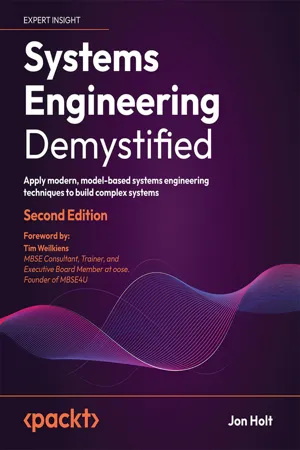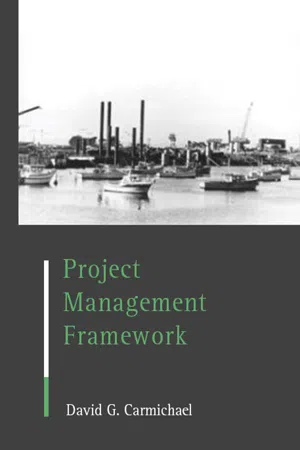Technology & Engineering
Project Life Cycle
The project life cycle refers to the stages a project goes through from initiation to completion. It typically includes phases such as initiation, planning, execution, monitoring and controlling, and closure. Each phase has specific deliverables and objectives, and the project life cycle provides a structured approach to managing and delivering projects.
Written by Perlego with AI-assistance
Related key terms
Related key terms
1 of 4
Related key terms
1 of 3
10 Key excerpts on "Project Life Cycle"
- Robert A. Powell, Dennis M. Buede(Authors)
- 2008(Publication Date)
- Berrett-Koehler Publishers(Publisher)
The project management life cycle provides a framework for the project manager to use to manage the project in an organized manner. The life cycle describes how a project progresses through a succession of stages; it is a logical sequence of activities needed to accomplish a project’s goals or objectives. Project activities must be grouped into stages because by doing so the project manager and the project team can efficiently and effectively plan and organize resources for each activity. This also allows the project manager and the project team to objectively measure the achievement of goals and justify their decisions to move the project to the next stage, make modifications to the project plans, or terminate the project. The project management life-cycle structure is of use to the project manager for the following reasons:The project manager can use the project management life cycle to organize project management activities and to identify resources needed to support each stage.The project manager can identify the collection of activities for each stage before proceeding to the next stage.The project manager can effectively consider the impact that early decisions have on later stages of the project management life cycle, particularly with regard to various risks. (Precedence in decisionmaking is covered in greater detail in Chapter 5 .)Success in the project management life cycle requires establishing the management process for the entire life cycle of the project that is needed to reach the project’s objectives (Forsberg, Mooz, and Cotterman 2000). In this vein we propose a management process for the life cycle of the project that consists of six stages, as depicted in Figure 3-1 : (1) Conception, (2) Feasibility Analysis, (3) Planning, (4) Implementation, (5) Controlling, and (6) Termination.FIGURE 3-1 : Project Management Life CycleWithin the life cycle, the project transitions from its conception to its eventual termination in a logical sequence that facilitates project decision-making. Many decisions occur in each stage and must be adequately addressed as a project progresses.- eBook - ePub
- David E. Avison, Gholamreza Torkzadeh(Authors)
- 2008(Publication Date)
- SAGE Publications, Inc(Publisher)
Chapter 3 we will also look at more formalized methodologies to develop information systems.Figure 1.6Life Cycle of an Information Systems Project—More Detailed• Initiation stage: At this stage a project is initiated and commitment is made. A person, group, unit, or units within the organization may initiate the need for a system. This might have been identified when a problem arises in the organization or a need for change is recognized. Usually a process is then followed to determine whether the idea should be supported or not. Sponsors of the idea must make the case as to why the new system is needed and how it helps organizational objectives. This is a challenging task since there are often competing proposals for limited resources. Proposals that are closely aligned with organizational strategic objectives have a better chance of receiving top management support. At this stage, someone is appointed as the manager of the project who will be responsible to carry out the project through the development life cycle and deliver the final product, assuming the project comes to fruition. This is the project manager.• Planning stage: At this stage the project scope is defined as clearly as possible, objectives are described, and activities are planned. Team members are identified and responsibilities are assigned. If the project manager was not appointed at the initiation stage, someone will be assigned at the early stage of planning. At this stage, the project manager needs to estimate cost, schedule work, form the team or teams, assign responsibilities, establish a communication mode, plan quality control, and design risk analysis. If there are different information systems proposals for achieving the objectives, a choice needs to be made between alternatives. Sometimes there are constraints that limit choice, but the solution agreed on needs to be technologically reliable, reasonable to schedule, economically worthwhile, and organizationally acceptable. Specific and unique resource needs are also identified and commitments are obtained. For example, depending on the scope and nature of a project, specialized know-how and expertise may be necessary. The project manager must in such cases determine whether in-house expertise is adequate to satisfy the project needs or whether arrangements need to be made to obtain external assistance. Planning activities are critical to the success of project management since they map out what needs to be accomplished, how they are accomplished, how progress is monitored, how quality is controlled, and—in short—how the project is managed. Since estimates of resources and activities are not always projected accurately, planning must allow for some flexibility in this respect. Things are not cast in stone. A project plan may need adjusting during the development phase. However, changing the plan must - John M. Nicholas, Herman Steyn(Authors)
- 2020(Publication Date)
- Routledge(Publisher)
IISystems development and Project Life Cycle
3 Project Life Cycle and Project Conception 4 Project Definition and System Definition 5 Project Execution and CloseoutMost systems move through a series of developmental stages. In human-made systems, the developmental stages follow an intentional, logical sequence of prescribed activities called the systems development cycle. Project management occurs within this cycle and is the function responsible for planning the work activities and organizing and guiding their execution. The three chapters in this section introduce the systems development cycle and describe its first three phases: conception, definition, and execution and closeout—the Project Life Cycle.Passage contains an image
Chapter 3Project Life Cycle and project conception
There is... a lime to be bom, and a lime to die; a time to plant, and a time to reap; a time to kill, and a time to heal; a time to break down, and a time to build up.—Ecclesiastes 3:1One feature of the systems approach is the concept of “life cycle”—the basic pattern of change that occurs throughout the life of a system. Two ways the systems approach accounts for this are to (1) recognize the natural process that occurs in all dynamic systems—that of birth, growth, maturity, and death, and (2) incorporate that process into the planning and management of systems. The practice of project management does both.The process of developing, implementing, and operating any human-made system follows a logical sequence of phases called the systems development cycle. Projects also follow a sequence of phases from beginning to end called the Project Life Cycle. This chapter describes the system development and Project Life Cycles and the first phase of both, conception.3.1 Project Life CycleSystems are dynamic—they change over time. Often, the change follows a distinct pattern that is repeated again and again. Mentioned in Chapter 2- eBook - ePub
The Hands-On Project Office
Guaranteeing ROI and On-Time Delivery
- Richard M. Kesner(Author)
- 2003(Publication Date)
- Auerbach Publications(Publisher)
Once the IT organization designs and implements a common process in keeping with its own needs and corporate culture, project management will help streamline delivery and eliminate more costly one-off exercises. The key to success here is the broad adoption of simple, uniform — yet flexible and well documented — processes by IT personnel. Flexibility is important because each project and each customer relationship has its own unique dynamics. With a project in which the IT organization and the customer have lots of experience together, the management process can be more informal. Conversely, high-risk projects demand considerable rigor in the application of project management principles. But do not confuse rigor with rigidity. The process must be pliable, refocusing work effort and related resources as business requirements evolve and as emerging technologies transform the IT landscape. Bear in mind this need for flexibility and adaptability when applying the frameworks discussed below.THE IT PROJECT MANAGEMENT LIFE CYCLE — A BRIEF OVERVIEW
All projects evolve through a natural life cycle, from inception and definition to design and construction to delivery and ongoing support. The key to successful project management is to balance the need for control against the degree of risk evidenced in the project’s scope. Go for a simple management framework or checklist and rely on published sources to supplement your efforts and to fill in any process gaps when confronting unusual or extremely complex projects.* As a starting point, consider the model shown in Exhibit 2 . This framework assists the IT team in building an appropriately detailed plan and oversight process to deliver a given project successfully. Remember to adapt this tool to meet the particular needs of your project and organization. See Exhibit 2 .This framework begins with a reiteration of the various phases of the project management life cycle, including commitment, analysis, design (from both business and technical perspectives), infrastructure readiness, development, certification, launch, release, and sunset.** For each phase I then provide a summary list of activities, deliverables or desired outcomes, and the parties responsible. Many components of this model will be familiar; others may require a more detailed explanation. For example, the commitment phase, which is often given short shrift in actual project execution, is dealt with in some detail in the next section of this chapter. This chapter also devotes considerable attention to ongoing delivery management, communication, measurement, and reporting. To begin, let us consider each phase of the framework in a little more detail. See Exhibit 3 - eBook - ePub
Systems Engineering Demystified
Apply modern, model-based systems engineering techniques to build complex systems, 2nd Edition
- Jon Holt, Tim Weilkiens(Authors)
- 2023(Publication Date)
- Packt Publishing(Publisher)
Utilization Stages, it is important to consider the Life Cycle of these Technologies. For very long-term Products, it may be necessary to ensure that the Technology that was used as part of the solution remains available for the duration of the Life Cycle, even if the Technology becomes obsolete. As an example of this, consider music media being played in a car.In the 1980s, this would have been a cassette; in the 1990s, a compact disc; in the 2000s, a connected device (such as a phone or media player); and in the 2010s, this would tend toward direct streaming.It is important, therefore, to understand the Stages that are involved in a Technology Life Cycle, as shown in the following diagram. Figure 4.5: A Life Cycle Definition View showing the Stages of a Technology Life CycleFigure 4.5 shows a Life Cycle Definition View, using a SysML block definition diagram, that shows the four Stages identified for this Life Cycle:- Research and Development : The Research and Development Stage represents the point where investment is being made in new Technology that has yet to establish a return. The risk of adopting such Technology is high.
- Ascent : The Ascent Stage represents the point where there is more widespread adoption of the Technology. The risk associated with adopting such Technology is lower than in the previous Stage but still exists.
- Maturity : The Maturity Stage represents a well-established Technology where the risk associated with adoption is low.
- Decline : The Decline Stage represents the point where the Technology is no longer being used as widely as before and the end of its adoption can be foreseen. There is an increased risk associated with adopting Technology at this Stage.
The Technology Life Cycle is important as the System Life Cycle will depend on it since it is dictated by the type of Technology adopted as part of the System solution. This is particularly important where the System Life Cycle is long (for example, if it is measured in years), as Technologies will become obsolete over time. - eBook - ePub
Project Life Cycle Economics
Cost Estimation, Management and Effectiveness in Construction Projects
- Massimo Pica(Author)
- 2016(Publication Date)
- Routledge(Publisher)
Archibald and Archibald 2013 ) that:Important improvements can be achieved by applying Systems Thinking to the Project Life Cycle Management System used for each project category.Understanding your Project Life Cycle can provide a justification to the actions required to manage a project. As Frame emphasizes in his book (1994 ):Where you are in the Project Life Cycle will have a strong bearing on what you should be doing and what options are open to you.Usually, the Project Life Cycle goes through its phases at a variable degree of intensity. Levels of resources and costs are rather low at the project inception, then the effort progressively increases up to a maximum point in the implementation phase. In the termination phase, a rapid decline occurs. Therefore, resource planning must take place as early in the Project Life Cycle as possible; control activities are expected to be more intense as the Project Life Cycle progresses.Across the project phases, there is usually a variable influence over the definition of the final project output and also over the final costs and benefits. The highest degree of influence is expected at the beginning of the project; this degree of influence drops as the project proceeds, whereas costs continue to accrue. As a consequence, the ability to add value to the project output decreases from the initial project phases onwards; therefore, early project management efforts should be dedicated to the effective and timely balance of perceived benefits against estimated costs.There is also, to some extent, another factor that challenges Project Management efforts: a culture of optimism that affects project cost and schedule performance by increasing the difficulty of developing and maintaining realistic estimates. Especially for projects that are technically complex, underestimating these technical elements leads to a larger extent of cost and schedule challenges: technologies may be new and unique, they may combine their interactions and they may require the utilization of expensive resources. This is particularly true at the implementation stage of the Project Life Cycle, when cost and schedule estimates will be used for the assessment of project execution. - eBook - ePub
- Denis Reardon(Author)
- 2006(Publication Date)
- SAGE Publications Ltd(Publisher)
The life cycle is shown in Figure 5.1. The idea of the Project Life Cycle is valid whatever the size and nature of the project, the larger and more complex the project, the more detailed and extensive the life cycle will be. The cycle shown is for an undergraduate project and so is relatively straightforward. This cycle traces your project from the initial idea through the preparation of the research plan, doing the research, including the analysis of the results, the determination of whether the aims and objectives have been realised, to submission of the final report and reflection on the research once it is complete. The cycle is presented in four stages: Define – Design – Do – Deliver. The ‘ define ’ stage is concerned with establishing precisely what you will be investigating: the scope, aims, objectives and limits of the work, and justification for it. It also defines the project in terms of the resources that will be needed, such as finance and people, consumables, facilities and equipment. The resources and other requirements should be carefully estimated since, in the normal course of events, it is not possible to change requirements significantly once a project is underway. Such a detailed definition is necessary because the design of the project is heavily dependent upon what will be available to do the research. For example, you may be distributing relatively complicated questionnaires in such numbers that they require machine analysis on return from respondents. The initial design of these questionnaires and their subsequent setting up for machine analysis can be complicated, time-consuming and costly. If you intend to interview subjects, remember that transcription of tape-recorded interviews may require substantial time and the assistance of appropriately skilled clerical staff - eBook - ePub
- D.G. Carmichael(Author)
- 2005(Publication Date)
- CRC Press(Publisher)
A broad plan, of course, would have been developed at the start of the project. Trouble with using the idea of phases comes about when it is recognised that there can be a blurring of activities across phase boundaries. All project activities are not sequential or serial in nature; feedback occurs between activities as ideas and information are consolidated. The idea of phases nevertheless, provides a useful way of distinguishing between an ongoing enterprise and a project. With an ongoing enterprise it is possible for all phases to be active at any one time, while a project progresses from one phase to the next. A project is a system. A system can be broken into subsystems with interaction between the subsystems. Each subsystem is itself a system which can be further broken down. A project then can be thought of as being composed of interacting subprojects. In general each phase would correspond to a subproject (Fig. 2.4). Figure 2.4 Project phases as subprojects. 2.3.4 Project Life Cycles Together the project phases are referred to as the Project Life Cycle. The term cycle is reasonably well accepted terminology amongst project personnel. The choice of the term is regarded by some people as unfortunate because it is argued that there is no cycle involved – a new project doesn't grow following the death of a project by analogy with biological systems. To other people the term cycle is an appropriate term as it is argued that a project starts from nothing, develops a life of its own then passes on to nothing, thus completing a loop. The term life cycle emphasises this time basis of projects. This is particularly evident when viewing the growth and decline of the project team, utilisation of resources etc over the life of a project - eBook - ePub
- John Carroll(Author)
- 2012(Publication Date)
- In Easy Steps Limited(Publisher)
10Project StagesThis chapter deals with the project stages, the high-level building blocks that make up the project. It begins with the Project Life Cycle and number of stages. It then provides a list of typical tasks and deliverables for each project stage.Project Life CycleProject Road MapWhy Five Stages?The Early StagesInitiation StageProject Initiation DocumentStrategy StageAnalysis StageDesign & Build StageThe Build ProcessImplementation StageSummaryProject Life CycleThroughout this book we have referred to and used five project stages for consistency. The full Project Life Cycle consists of these five stages, together with project start up and project closure. These are illustrated on the project road map opposite.Project Start UpThe project start up procedure was covered in Chapter two : Getting Started. In summary, it is about getting everything prepared for the project to start.The initiation stage was covered and referred to in a number of chapters. The two main reasons for the initiation stage are to get the project team working and to plan the project.Initiation StageThe strategy stage is where we define the strategic business requirements. What the business really wants the project to deliver.Strategy StageIn the analysis stage, we start to identify what will have to be done in order to meet the business requirements. We also start to think about how we will implement what the project will deliver.Analysis StageDesign & Build StageThis is where the detailed work of the project is carried out. First, we design how we will meet the business requirements, and then we proceed to build the necessary products and systems to do it. At the end of the design and build stage, everything should be ready to go.Implementation StageDuring implementation, we bring the new processes or procedures we have designed and built into use. We train the staff who will be using them and we provide them with support while we cut over to the new way of doing things. - No longer available |Learn more
- Elizabeth Harrin(Author)
- 2021(Publication Date)
- Project Management Institute(Publisher)
Chapter 5 Team Management and Project Management Life CycleP rojects are done by teams. OK, occasionally I have found myself working on something very small, all by myself. But most of the time, project managers lead a team of people working towards a common objective.Social media tools, as we saw in Chapter 3 , bring people together. These tools can help facilitate the management of groups of people. However, before I jump in and explain how that works, we will look at what project team management actually looks like during the project management life cycle. You know you do it, but have you ever thought about what it really involves? Project teams come with different challenges to other types of teams, not least because our team structures only exist until the objective is achieved. This chapter will also look at common issues with managing project teams due to their unique nature.Finally, we'll look at how social media tools fit into all this, and how they can help you manage your team more effectively. The Project Management Life Cycle: The Team Management ViewProjects are a collective effort—it takes a group of people to deliver most projects as they tend to have transformative effects that an individual can't achieve alone. Even if you are the only person working on it, chances are that the outcome will affect other people and you will have to involve them at some point. Projects have a common objective, and achieving those objectives is a team effort: if someone lets the team down, the project misses milestones, tasks are delayed, and the project manager ends up with a whole lot of replanning and explaining to do. So managing a team is an important skill for a project manager.The thing is, being a team doesn't just happen. No team works effectively from the very first day they are thrown together. It takes time to build good working relationships with people and establish the trust that makes it possible to lean on each other during the difficult patches. Bruce Tuckman published a theory of team development in 1965 that shows that small groups of people working together go through five stages:
Index pages curate the most relevant extracts from our library of academic textbooks. They’ve been created using an in-house natural language model (NLM), each adding context and meaning to key research topics.
Explore more topic indexes
Explore more topic indexes
1 of 6
Explore more topic indexes
1 of 4









